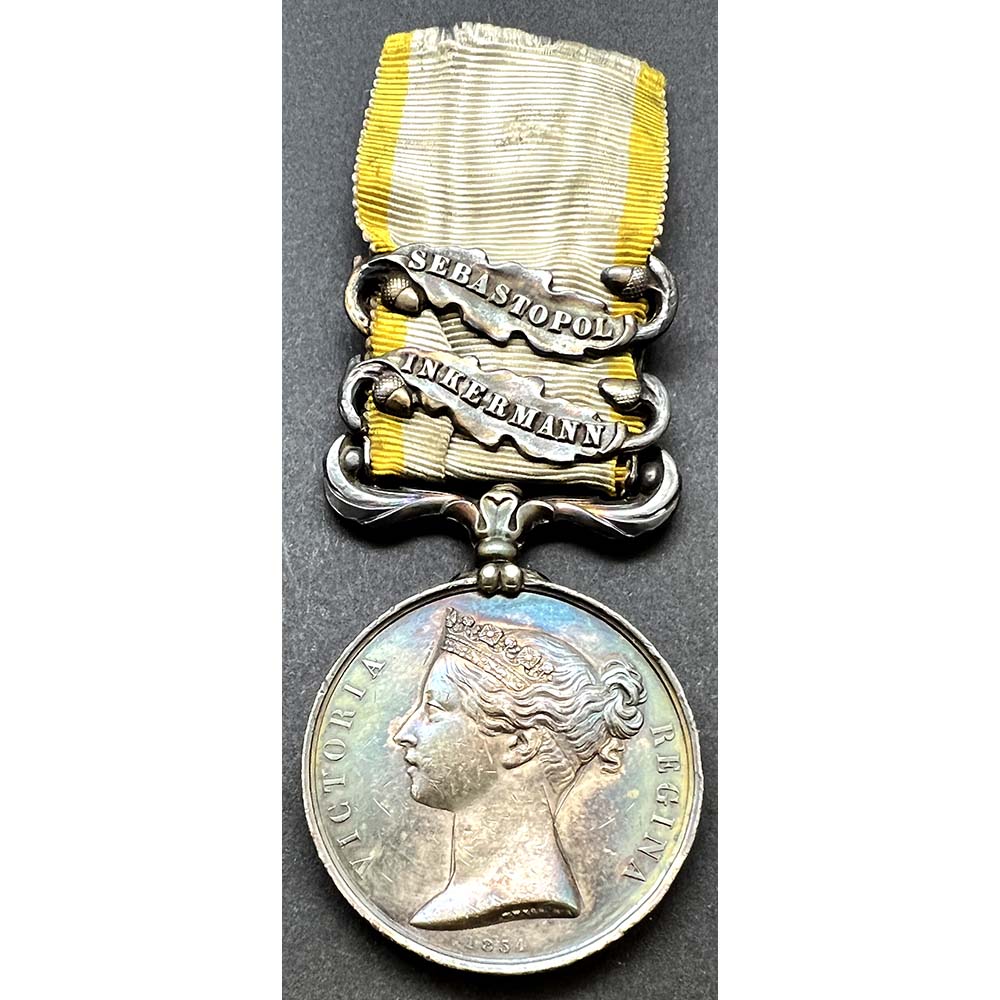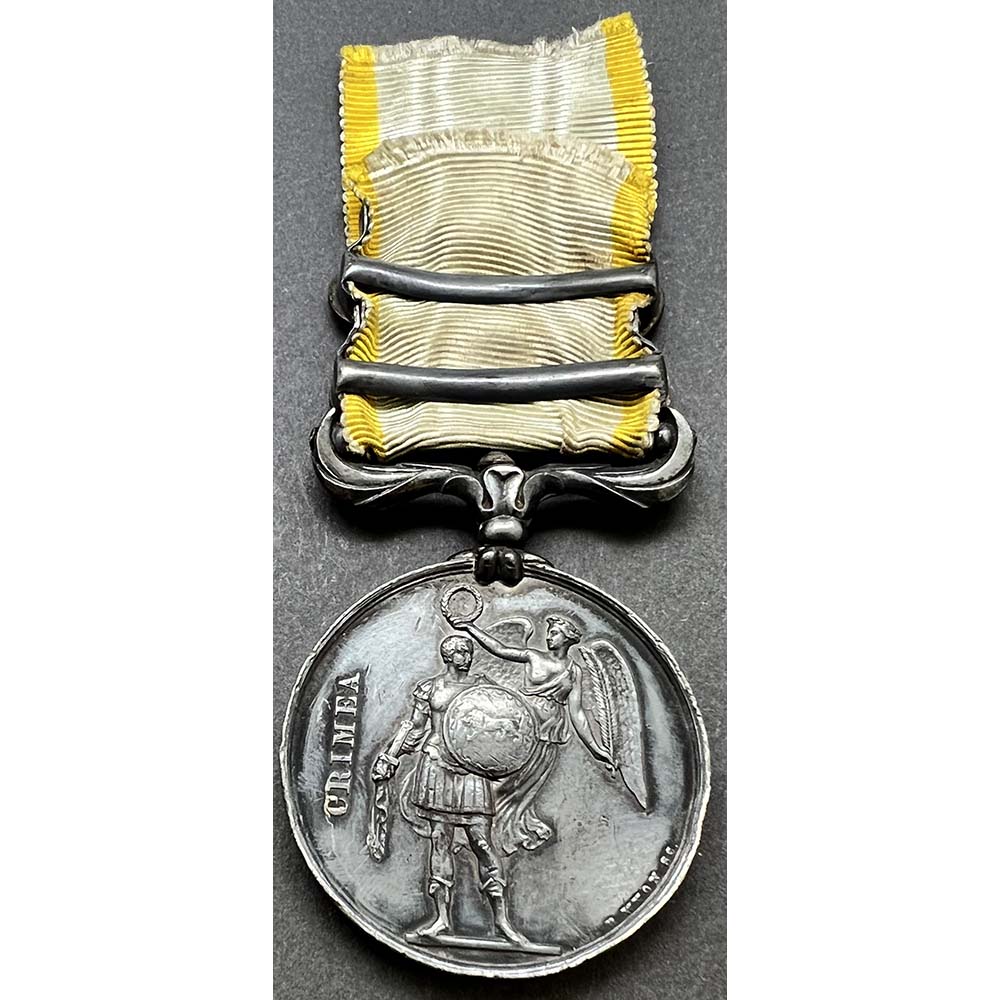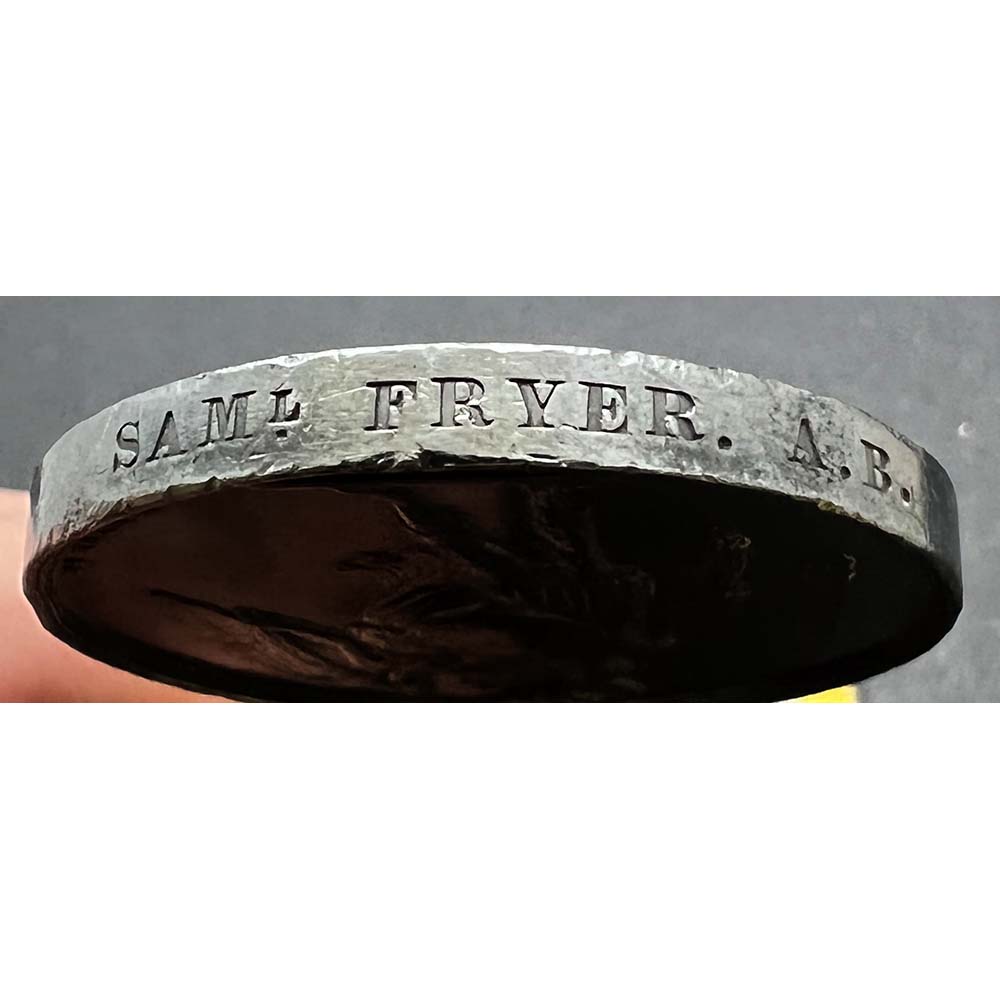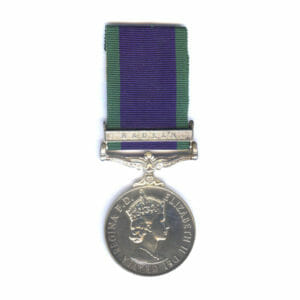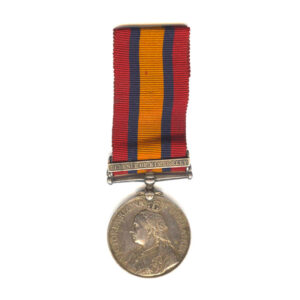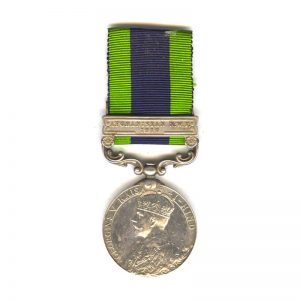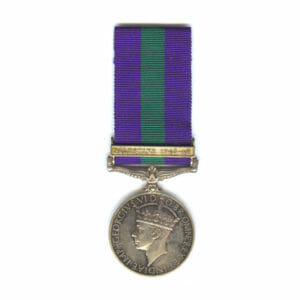Description
Crimea Medal, 2 bars, Inkermann, Sebastopol, Samuel Fryer, Able Seaman, HMS Rodney, present at both battles, officially impressed as issued to the Rodney.
“Walking at the head of the Noble Society (of Watermen) were 5 young men, who had served their Queen and Country and who proudly wore their well deserved Medals: the names of these brave fellows were: SAMUEL FRYER, of the Naval Brigade…”
Officially impressed naming: “Saml Fryer. A.B.”
Some minor edge bruising, taking on an attractive dark tone over the years, very old piece of silk ribbon and looks like the bars are officially riveted as issued.
Confirmed on the medal roll as present at both Sebastopol and Inkermann with the Naval Brigade, detachment sent ashore from HMS Rodney.
From a brief read, The Naval Brigade roll for Inkermann records only approximately 115 recipients of the Inkermann Clasp to the Rodney.
Macclesfield Courier and Herald, 9th January 1858, reports the presence of local Waterman’s Society’s 5 proud Crimean Veterans wearing their medals, marching at the head of 400 men.
“THE RIVER WEAVER WATERMEN’S SOCIETY – On tuesday last, an imposing and interesting demonstration took place at Northwich, in the procession of the society above named. Upwards of 400, headed by the Northwich Temperance Band, and banners with appropriate mottoes, and the officers of the society with their staves of office…
…Without any disparagement to the population of the county of Chester, a finer body of men does not exist in the Kingdom – they are an honour to the country and would prove ‘ugly customers’ to thrice their number of their country’s foes.
There are several features in this society of curious interest. There are two captains…
…Then, the Temperance Band, which may challenge competition with most provincial Bands, included among its members, 8 brothers, the sons of Mr Thomas Fryer the valued agent at Messrs Caldwell’s Salt Works, at Anderton.
Walking at the head of the noble society, were five young men, who had served their Queen and Country and who proudly wore their well deserved medals: the names of these brave fellows were, Thomas Poole, of the Sans Pareil, in the Black Sea, and the Russell, in the Baltic; SAMUEL FRYER, of the Naval Brigade…”
Samuel Fryer, was born about 1830 in Northwich, Cheshire.
He saw his first ship posting on 10th May 1852, when he joined HMS Rodney.
He served on her throughout the entirety of the Crimean War, with some time in the field in Crimea.
He served first from 10th May 1852 until 22nd November 1854, under the commission of Captain Graham who noted his service as “Good”.
During this time she served in the Black Sea during the “Baltic” campaign.
He then stayed on for her second commission, from 23rd November 1854 until 30th January 1856. Capt Moorsom signed him off as “Good”.
With his old Captain Graham being invalided, command was assumed by the enigmatic Captain Henry Keppell, who took his men ashore to form the Naval Brigade.
“In the Battle of Inkermann, fought on November 5th, 1854, 600 men of the Naval brigade were present in the field, the rest being in the batteries.
The right Lancaster Battery, where acting Lieut William Hewett commanded, on the extreme right of the left attack, and where Lancaster Guns and 3 68 Pounders were mounted, was fiercely but vainly assaulted by the Russians.
5 Bluejackets, picking up the rifles of disabled soldiers, mounted the banquette, and, with extraordinary heroism and coolness, under a storm of bullets, kept up a rapid fire against the enemy, while other seamen below loaded and handed up fresh weapons.
2 of these gallant fellows perished, but the survivors, Thomas Reeves, James Gormsn, and Mark Scholefield, were deservedly given the Victoria Cross.
Sir Edmud Lyons, who had been present at Balaklava, was also present on shore at Inkermann. So, also, were Captain Sir William Peel, and his ADC, Midshipman St John Daniel. They joined the Officers of the Grenadier Guards, and assisted in defending the colours of that regiment when they were in danger of capture at the Sandbag Battery. Both Peel and Daniel it should be added, won the Victoria Cross, and both deserved it on more than one occasion.
the British naval camp before Sebastopol was shifted to a new site about a mile and a half more to the left, on the right bank of the upper part of the long ravine leading down to the head of the Dockyard or Inner Harbour.” – W.L. Clowes on the Russian War.
After returning home he was posted to HMS Victory, being assigned as a Stoker to Her Majesty’s Gun Boat Blazer on 24th March 1856.
The newly launched Blazer was in need of a fresh crew, being commissioned on 11th March 1856 by Lieutenant Loftus Christopher Hawker Robinson (Brother of the 1st Baron Rosmead).
He joined the HM Gunboat Blazer and served through the year, until he was discharged to shore having been paid off, again his service was noted as “Good”, on 13th September 1856.
The Gun Boat Blazer did not last long in HM Service, being paid off into the Steam Reserve in August 1856, along with her crew.
According to the Royal Navy Description book on his discharge:
He was 26 years old, 8 months, standing 5 foot 6 inches tall, with a ruddy complexion, blue eyes and dark brown hair.
Samuel Fryer, was born circa 1830 in Cheshire.
The 1841 Census records him as the son of Thomas and Sarah Fryer, of Winnington, Budworth, Northwich, Cheshire.
Part of a massive Cheshire family, being amongst 12 children, he was the valued Agent of the local Salt Works.
The 1851 Census records him as still living in Winnington, but employed as a “Waterman”
He is noted in the British Merchant Seamen Records as under their employment before joining the Royal Navy circa 1845-1852.
The local Watermen of Northwich would pass up and down the Northwich Waterways, taking part in the important role in transporting salt, one of Northwich’s biggest industries.
Northwich is well connected by the River Weaver, with access to the River Mersey, allowing access all the way to Manchester City Centre if needed.
After his time in the Navy during the 1850s, he returned back home to Cheshire.
In 1861 he had started his own family back in Witton, Cheshire
Working as a Waterman, he had married Jane, a local girl and had 2 children, Mary E. (aged 3) and James, his 1 year old son.
In 1871, he was living in Barnton, Northwich, Cheshire, and had added another daughter, Julia.
He appears to have died in Northwich during 1874.
